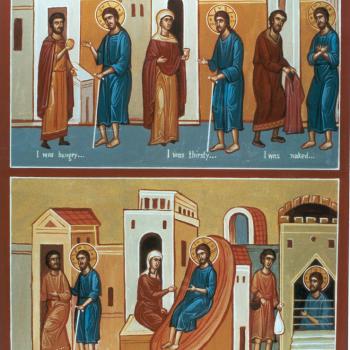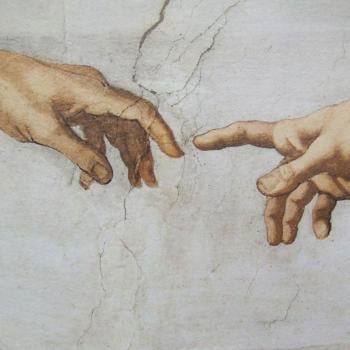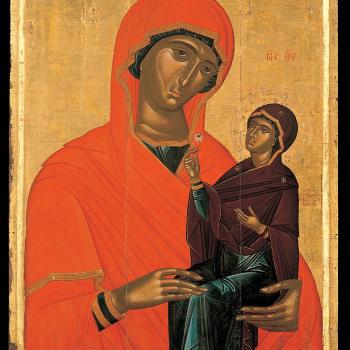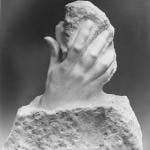Signs, symbols, and figures. Often, one of these words implies the others, as can be seen throughout the marginal notes of a medieval translation of Pseudo-Dionysius’s Ecclesiastical Hierarchy: “Symbols – figures and signs” (Symbolorum – figurarum et signorum.). [1] “Symbols – that is, signs or figures” (Symbola – id est signa vel figuras). [2] “Symbols – that is, signs.” (Symbolis – id est signis). [3]

Signs, symbols and figures all are used to communicate. Those who use them want to signify some element of the truth through them. Sometimes they do it by pointing out that truth in a sign or symbol has no other connection to that truth than some analogy being made through its use, but sometimes they do it using a sign which also contains the truth being signified within the sign or symbol itself.
Augustine discussed the meaning and value of signs in his work, On Christian Doctrine. He did so because Scripture, being filled with symbols, needs to be read with those symbols in mind. If people do not understand the symbolic content contained in Scripture, their reading will be incomplete if not erroneous.
Augustine began his work by saying that there are two types of signs. The first he designated as being natural. The second he indicated as being conventional:
Now some signs are natural, others conventional. Natural signs are those which, apart from any intention or desire of using them as signs, do yet lead to the knowledge of something else, as, for example, smoke when it indicates fire. For it is not from any intention of making it a sign that it is so, but through attention to experience we come to know that fire is beneath, even when nothing but smoke can be seen. And the footprint of an animal passing by belongs to this class of signs. And the countenance of an angry or sorrowful man indicates the feeling in his mind, independently of his will: and in the same way every other emotion of the mind is betrayed by the tell-tale countenance, even though we do nothing with the intention of making it known.[4]
Natural signs are those signs which can be found in the natural world, those things which we find all around us that we can use to understand and learn about the world around us. They often are elements of some nature which we can observe that indicate the presence of that nature itself. Thus, when we see there is smoke, we can infer that there is fire present. Smoke is a natural sign for fire. What was important is that a natural sign is made without any conscious effort. Thus, body language and the unconscious cues people give with it qualify as natural signs. Conventional signs are made and established by some conscious effort, creating conventions which require an interpreter, someone who knows the meaning of the convention, for them to be effective. They communicate meaning, but if one does not know the association of the sign or symbol with the meaning implied, it can be something which is not understood. Thus, for example, we know a red traffic signal means stop; it is a conventional sign with a meaning that is given to all who learn to drive so they know they must stop when they see a red light. Thus, conventional signs are established to communicate, but for the communication to be effective, both those who use the sign and those who are being communicated by it must know the relationship between the sign and its intended meaning:
Conventional signs, on the other hand, are those which living beings mutually exchange for the purpose of showing, as well as they can, the feelings of their minds, or their perceptions, or their thoughts. Nor is there any reason for giving a sign except the desire of drawing forth and conveying into another’s mind what the giver of the sign has in his own mind. [5]
Conventional signs can be established in a variety of ways. They can be very obscure and esoteric, so that only the initiated can understanding their meaning, or they can be related to and connected to some element of nature so that they are easier to understand. But, since a sign is established by the conventions of a particular community, outsiders can certainly find it difficult to interpret and understand the sign if they have not been given an explanation for the intended meaning (or the means to determine that explanation).
While sacraments are not merely signs or symbols, they come to us in and through such symbols, established both in their physical form but also in the ritual used to establish them, so that those who participate in the sacraments will be able to discern the truth being presented in and through them:
The doctors have designated with a brief description of what a sacrament is: “A sacrament is a sign of a sacred thing.” For just as in man there are two things, body and soul, and one in Scripture likewise two things, letter and sense, so also in every sacrament there is one thing which is treated visibly without and is seen, and there is another which is believed invisibly within and is received. What is visible without and material is a sacrament; the sacrament, however, which is treated and sanctified without is a sign of spiritual grace and this is thine thing of the sacrament and is received invisibly. [6]
Thus, with the sacraments, there is the physical aspect to them, an aspect which is often called the “sacrament” itself, and the thing which is being represented by the physical sacrament, the thing in itself, the grace of sacrament:
WHAT IS A SACRAMENT. – AUGUSTINE, IN BOOK 10, THE CITY OF God: “A sacrament is a sign of a sacred thing.” And yet a sacrament is also called a “sacred secret,” the sacrament of the Godhead, for example, so that a sacrament is a sacred thing which designates the sacred thing which is designated. But what is now at issue is the sacrament according to its being a sign. Also, a sacrament is a visible form of an invisible grace.[7]
The physical form of the sacrament, therefore is a symbol, and that symbol points to the grace contained within it. The grace is spiritual, and so not physical, making it invisible. The physical form is used so that we understand that we are receiving a reality which lies beyond our perception and comprehension:
Nor if anyone wishes to define more fully and more perfectly what a sacrament is, he can say: “A sacrament is a corporeal or material element set before the senses without, representing by similitude and signifying by institution and containing by sanctification some invisible and spiritual grace.” This definition is recognized as so fitting and perfect that it is found to befit every sacrament and a sacrament alone. For every thing that has these three is a sacrament, and everything that lacks these three can not be properly called a sacrament. For every sacrament ought to have a kind of similitude to the thing itself of which it is the sacrament, according to which it is capable of representing the same thing; every sacrament ought to have also institution through which it is ordered to signify this thing and finally sanctification through which it contains that thing and is efficacious for conferring the same on those to be sanctified. [8]
Peter Lombard, therefore, considered a sacrament to be a physical sign or symbol, while acknowledging what we receive is more than the symbol. Thus, he mentioned that there are three things involved in our reception of the sacraments: the physical sacrament, the grace, and the union of the two:
And so there are three things to distinguish here: one, which is the sacrament alone; another, which is a sacrament and thing; a third, which is thing and not sacrament. The sacrament and not thing is the visible species of bread and wine; the sacrament and thing is Christ’s own flesh and blood; the thing and not sacrament is his mystical flesh. – Moreover, that visible species is a sacrament of a double thing, because it signifies either thing, and bears the express likeness of each of the two. For just as bread restores and sustains the body more than other foods, so wine gives joy to and inebriates man, so the flesh of Christ, more than other graces, spiritually restores and nourishes the interior man; hence: Your chalice inebriates; how magnificent it is! –It also has the likeness of a mystical thing, which is the unity of the faithful, because, just as one loaf of bread is made from many grains, and wine flows into one from many grapes, so the unity of the Church is composed out of the many persons of the faithful. [9]
Sacraments, by their nature, are symbolic; the physical aspect of them is traditionally understood to be what we designate as the sacrament. The grace is one with the sacrament but it is not the same thing as the physical form. Thus, the physical form which we experience is a symbol pointing to that grace, a grace which is contained within the sacrament and so is not to be said to be other than the sacrament, and yet a grace which must not be confused with the symbolic element of the sacrament itself. We receive this grace when we partake of the sanctified sacraments, but it is important to realize that this is a grace which we can receive apart from the physical sacraments if God so wills: “Now God can save man without these, who can bestow upon man His virtue and sanctification and salvation in whatever way He wills.” [10] God is not bound by the sacraments, but we, who know of them and are guided and directed to them, are bound to them as the normative way to receive the graces signified by them. It would be impious to suggest that what is normative for us must be seen as the only way which such grace can be received, for those who would suggest this would put a limit on God:
You ascribe a necessity to sacraments and from the Author of sacraments you take away power and to Him you deny piety. You say to me that he who has not the sacraments of God can not be saved, and I say to you: “He who has the virtue of the sacraments of God can not perish.” Either deny that there can be virtue where there is no sacrament, or if you concede the virtue deny the damnation. Which is greater, the sacrament or the virtue of the sacrament? What is greater, water or faith? If you wish to speak the truth, say “faith.” [11]
The virtue, the grace, of the sacrament is the point of the sacrament. If God deigns to give us that grace apart from the sacraments, that is God’s prerogative, and not for us to reject. But we also know God has established the sacraments for us so we can receive their graces, and if we can obtain the sacraments for those graces, who are we to deny them and tell God how we want to receive them? It is for God to give them out as God wills, and for us to receive them in the way God has provided them to us; the key is to realize that God is not bound to the sacraments and can, with mercy and grace, give the grace of the sacraments, the thing signified by the physical sacraments, to those who have not received the physical sacraments. This is why we must not believe that those who have not received the sacraments will be damned for eternity; their status is known to God. It is for us to rest on the merciful and gracious love of God as a reason to hope that even those who do not receive the physical sacraments can be saved.
[1] Ed. and Trans., L Michael Harrington, On The Ecclesiastical Hierarchy: The Thirteenth Century Paris Textbook Edition (Paris: Peeters, 2011), 55.
[2] Ed. and Trans., L Michael Harrington, On The Ecclesiastical Hierarchy: The Thirteenth Century Paris Textbook Edition, 63.
[3] Ed. and Trans., L Michael Harrington, On The Ecclesiastical Hierarchy: The Thirteenth Century Paris Textbook Edition, 75.
[4] St. Augustine, “On Christian Doctrine” in NPNF1(2):535-6.
[5] St. Augustine, “On Christian Doctrine,” 536.
[6] Hugh of Saint Victor, On the Sacraments. Trans. Roy J. Deferrari (Cambridge: Medieval Academy of America, 1951), 154.
[7] Peter Lombard, The Sentences. Book 4. On the Doctrine of Signs. Trans. Giulio Silano (Toronto: Pontifical Institute of Medieval Studies, 2010), 3 [Distinction I, Chapter 2].
[8] Hugh of Saint Victor, On the Sacraments, 155.
[9] Peter Lombard, The Sentences. Book 4. On the Doctrine of Signs, 45 [Distinction VIII, Chapter 7].
[10] Hugh of Saint Victor, On the Sacraments, 161.
[11] Hugh of Saint Victor, On the Sacraments, 162.
Stay in touch! Like A Little Bit of Nothing on Facebook.
If you liked what you read, please consider sharing it with your friends and family!

















